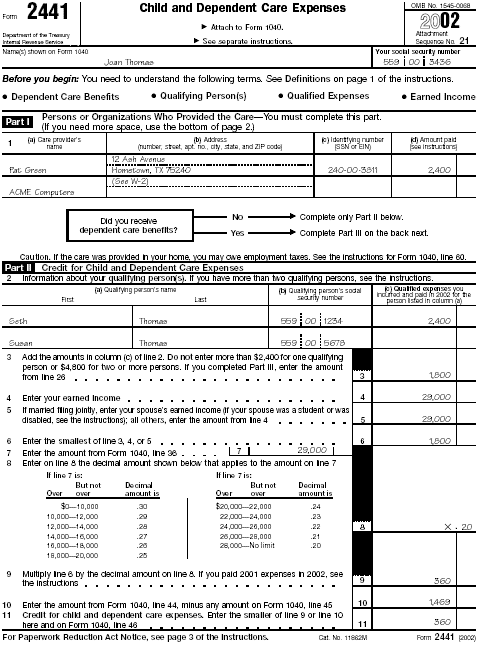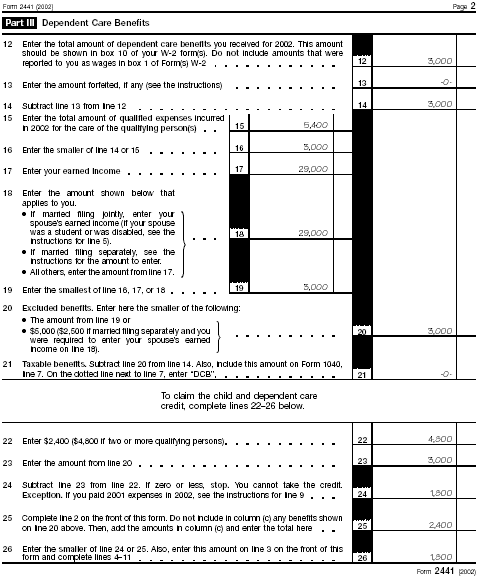How To Claim
the Credit
To claim the credit, you can file Form 1040 or Form 1040A. You cannot claim the credit
on Form 1040EZ.
Form 1040. You must complete Form
2441 and attach it to your Form 1040. Enter the credit on line 46 of your Form
1040. An example of a filled-in Form 2441 is at the end of this chapter.
Form 1040A. You must complete Schedule
2 (Form 1040A) and attach it to your Form 1040A. Enter the credit on line 29 of
your Form 1040A.
Limit on credit. The amount of credit you can claim is limited to
the amount of your regular tax (after reduction by any allowable foreign tax credit) plus
your alternative minimum tax, if any. For more information, see the instructions for Form
2441 or Schedule 2 (Form 1040A).
Tax credit not refundable. You cannot get a refund for any
part of the credit that is more than this limit.
 Recordkeeping. You
should keep records of your work-related expenses. Also, if your dependent or spouse is
not able to care for himself or herself, your records should show both the nature and the
length of the disability. Other records you should keep to support your claim for the
credit are described earlier under Provider Identification Test. Recordkeeping. You
should keep records of your work-related expenses. Also, if your dependent or spouse is
not able to care for himself or herself, your records should show both the nature and the
length of the disability. Other records you should keep to support your claim for the
credit are described earlier under Provider Identification Test.
Employment Taxes
for Household Employers
If you pay someone to come to your home and care for your dependent
or spouse, you may be a household employer. If you are a household employer, you
will need an employer identification number (EIN) and you may have to pay employment
taxes. If the individuals who work in your home are self-employed, you are not liable for
any of the taxes discussed in this section. Self-employed persons who are in business for
themselves are not household employees. Usually, you are not a household
employer if the person who cares for your dependent or spouse does so at his or her home
or place of business.
If you use a placement agency that exercises control over what work is done and how it
will be done by a babysitter or companion who works in your home, that person is not your
employee. This control could include providing rules of conduct and appearance and
requiring regular reports. In this case, you do not have to pay employment taxes. But, if
an agency merely gives you a list of sitters and you hire one from that list, the sitter
may be your employee.
If you have a household employee you may be subject to:
- Social security and Medicare taxes,
- Federal unemployment tax, and
- Federal income tax withholding.
Social security and Medicare taxes are generally withheld from the employee's pay and
matched by the employer. Federal unemployment (FUTA) tax is paid by the employer only and
provides for payments of unemployment compensation to workers who have lost their jobs.
Federal income tax is withheld from the employee's total pay if the employee asks you to
do so and you agree.
For more information on a household employer's tax responsibilities, see Publication
926 and Schedule H (Form 1040) and its instructions.
State employment taxes. You may also have to pay state unemployment
tax. Contact your state unemployment tax office for information. You should also find out
whether you need to pay or collect other state employment taxes or carry workers'
compensation insurance. A list of state employment tax agencies, including addresses and
phone numbers, is in Publication 926.
Example
The following example shows how to figure the credit for child and dependent care
expenses for two children when employer-provided dependent care benefits are involved. The
filled-in Form 2441 is shown at the end of this chapter.
Illustrated example. Joan Thomas is divorced and has two children,
ages 3 and 9. She works at ACME Computers. Her adjusted gross income (AGI) is $29,000, and
the entire amount is earned income.
Joan's younger child (Susan) stays at her employer's on-site child-care center while
she works. The benefits from this child-care center qualify to be excluded from her
income. Her employer reports the value of this service as $3,000 for the year. This $3,000
is shown in box 10 of her Form W-2, but is not included in taxable wages in box 1.
A neighbor cares for Joan's older child (Seth) after school, on holidays, and during
the summer. She pays her neighbor $2,400 for this care.
Joan figures her credit on Form 2441 as follows.
| 1) |
|
Work-related expenses Joan paid |
|
$2,400 |
| 2) |
|
Dollar limit (2 or more qualified individuals) |
|
$4,800 |
| 3) |
|
Minus: Dependent care benefits excluded from Joan's income |
|
- 3,000 |
| 4) |
|
Reduced dollar limit |
|
$1,800 |
| 5) |
|
Lesser of expenses paid ($2,400) or dollar limit ($1,800) |
|
$1,800 |
| 6) |
|
Percentage for AGI of $29,000 |
|
20%(.20) |
| 7) |
|
Multiply the amount by the percentage amount on line 6 |
|
$ 360 |
| 8) |
|
Enter the amount from Form 1040, line 44 |
|
$1,469 |
| 9) |
|
Enter any amount from Form 1040, line 45 |
|
- 0- |
| 10) |
|
Subtract line 9 from line 8 |
|
$1,469 |
| 11) |
|
Credit (Enter the smaller of line 7 or line 10) |
|
$360 |

Form 2441,Forms: 2441Page 1

Form 2441, Page 2
- Continue - |

